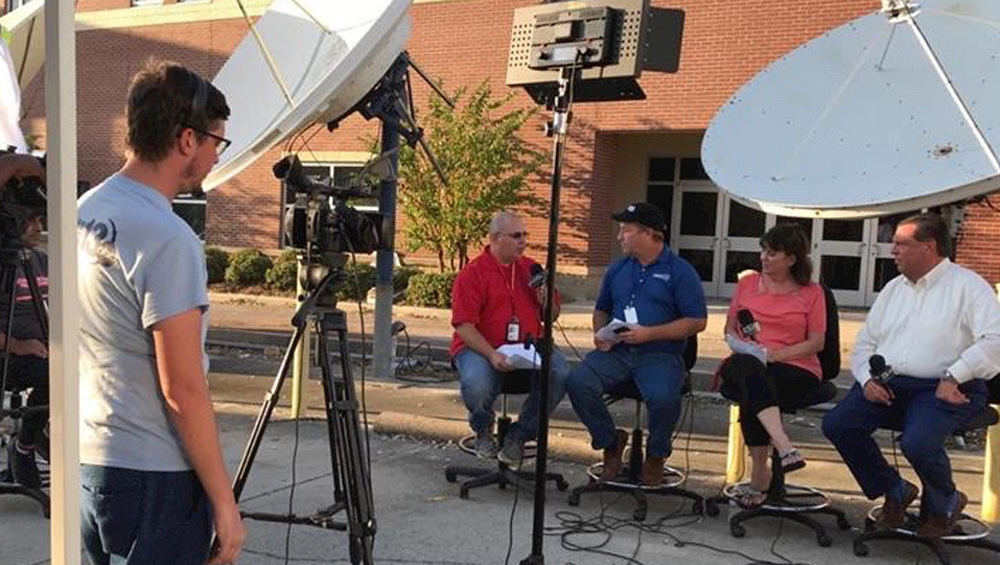
Hurricane Blew Through WMBB’s Disaster Plan

As Hurricane Michael approached Nexstar Media’s WMBB in the Florida panhandle town of Panama City (DMA 150) on Oct. 10, station management was feeling fairly confident.
They had a well-developed disaster plan. It was sound, says General Manager Terry Cole. “We went over it multiple, multiple times. Everyone knew it.”
But Mother Nature has a way of making hash of any plan. It would be 10 long days before the ABC affiliate could restore full local service, and operations are still far from normal.
“Every storm is different,” says WMBB Creative Services Director Chris Golden. “Our plan was based off Katrina, and that was a water event. This was a wind event. It was like a tornado sat on top of the city for two hours. Brick buildings around us had crumbled. We were like, ‘What happened?’ ”
The Plan
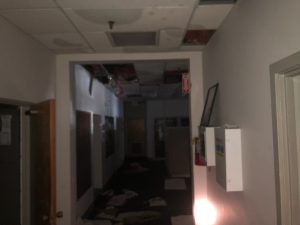
About 70% of the WMBB building in Panama City, Fla, is damaged. (Photo: Terry Cole)
The plan called for bringing all reporters into the building by a specific time so no one was stranded and endangered in what became a Category 4 storm. The station had a generator and an underground gas line to fuel it.
The sales department would provide food. Cots were stationed in offices so staff could sleep in shifts. The engineering department made sure the station had necessary equipment. The marketing department folded into the news department to help provide content. Staff were to travel in pairs.
Sister stations in the Nexstar family were queued up to pitch in. External security cameras could show the conditions outside. If the station had to evacuate, employees could go next door to the two-story First Baptist Church building.
The station was self-reliant. It had a generator fed by underground natural gas, on-site master control and didn’t hub any other functions.
“Basically, with backups, going into a storm, you think, ‘This is going to get bad, but we’ve got everything we need to stay on air,’ ” Golden says. “That wasn’t the case.”
The Storm
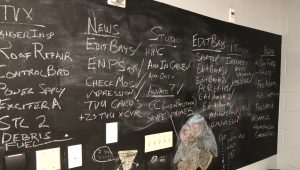
The engineers listed things they must be sure work or need to be fixed to get WMBB back on air. (Photo: Chris Golden)
With the leading edge of Michael packing winds of more than 130 mph, the National Weather Service in Tallahassee issued its first extreme wind warning at 9:19 a.m. “Storm surge is one thing, but wind is a whole different story,” Golden says.
The WMBB team hunkered down at the station, with some shooting video through the windows and garage. But the high winds on the leading edge of the storm proved too much for the station.
Parts of four different roofs hit the WMBB building. “It was terrifying,” Golden says.
The fourth roof — from the church next door — nicked the natural gas line at 12:40, shutting down the generator and knocking the station off the air. The RF chain was also later broken by damage to the STL and to the transmitter.
“We probably would have been OK if that roof hadn’t fallen on us, but once it did, it punched holes in our roof, and it was game over,” Golden says.
Although wireless service was spotty by the time the generator went dark, T-Mobile service was still good enough that the station was able to continue “broadcasting” via Facebook Live. A reporter in adjacent Walton County was able to also contribute some reporting.
Because of the roof and the presence of natural gas in the air, employees evacuated to the church next door at 3-3:30 p.m., by which time the wind speed had fallen to around 50 mph. Staffers had to pound on the church door with a crowbar to get in.
Although the church had lost its roof, the first floor of the two-story building was intact and was able to provide sanctuary.
WMBB Chief Engineer Laurence Richesin says his chief concern was keeping water out of the building. “When we realized the whole roof had been compromised, we told everybody, ‘Don’t worry about it, you can’t stop the water, just keep yourself dry’.”
With the station silenced, Nexstar’s WFLA Tampa, Fla., soon began producing newscasts for the market and would continue doing so for the next 10 days. A satellite truck was used to send video back and forth between Tampa and Panama City.
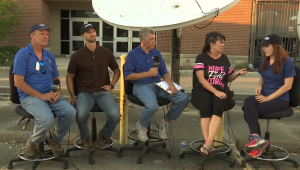
The WMBB building lost power, so the team set up in the station’s parking lot for this evening broadcast. L-r are Chief Meteorologist Justin Kiefer, Meteorologist Ross Whitley, Evening Anchor Jerry Brown, Evening Anchor Amy Hoyt, and Morning Anchor Kelsey Peck. The building in the background is First Baptist Church Panama City, where the staff spent the night after evacuating there following the storm due to the damage to its building. The dish behind the anchors has since had to be replaced due to warping in the storm. To get the newscast to WMBB viewers, the station used WKRG Mobile, Ala.’s satellite truck to uplink, then WFLA Tampa pulled the signal back down and fed it out to MyPanhandle.com and Facebook. (Photo: Chris Golden)
But the Panama City crew wasn’t done. They set up a makeshift outdoor studio in the station parking lot and as repairs were being made to the station and to the RF facilities, they produced local news segments, eventually as much as six hours a day.
The outdoor set-up used “remnants of the roof in the background as our set piece,” Cole says.
On Oct. 20, WMBB was back on its feet, producing newscasts from inside the station and broadcasting over the restored STL and transmitter.
Crucial to restoring service was help was help from other Nexstar stations. Within 24 hours of the hurricane, the “Nexstar Nation” in the persons of news directors, anchors and other roles began arriving in Panama City to help.
“They said: ‘Your lives just got destroyed and you’re serving your community. Let us do that so you can take care of yourself,’ ” Cole says.
“They helped us for three weeks. I’ve never seen anything like it. Our plan was good, but the damage was so severe that we couldn’t have made all the repairs and gotten back on air without the Nexstar Nation.”
The New Normal
Although the station is now back on the air, operations are normal only so far as what the viewers sees at home, Richesin says. “We’ve got technical equipment crammed into one room at the moment.”
The roof is partially gone and 70% of the building can’t be inhabited.
Key equipment outside is damaged and may take months to repair. On the upside, master control and the studio are largely intact. “We got lucky there,” Cole says.
While there was water damage, most of the equipment racks also escaped damage, he says.
The Lessons
An updated version of the emergency plan will address lessons learned from Michael.
Wireless service proved inadequate. The station didn’t have a satellite phone during the hurricane, but will next time, says Cole. “We may never need it, but when you need it, you need it.”
In addition, Cole says, having mobile hotspots and service from different providers makes a lot of sense.
Additional battery sources, ways to recharge the camera batteries, extra small gas generators and laptop editors are all items Golden wants to include in the updated plan.
“We thought we had a generator. We bought perishable food. When we lost power, we lost food like everyone else,” Golden says. “Just because you’ve got a generator, don’t count on it.”
So many trees clogged the streets that WMBB had to find a crew to plow a path down the road in front of the station building.
“There were signs up that said, ‘Last gas for 65 miles,’ ” Golden says. “There wasn’t a gas station open for two weeks.”
The station needed more fuel brought in for news crews and generators.
“Fuel becomes a very important thing,” Golden says.
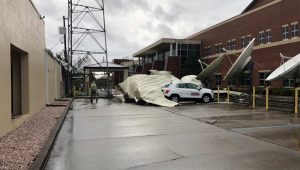 Visiting Nexstar employees staying in hotel rooms in neighboring counties were bringing full cans of fuel to help keep news crew vehicles moving.
Visiting Nexstar employees staying in hotel rooms in neighboring counties were bringing full cans of fuel to help keep news crew vehicles moving.
Despite plowing of roads, debris remained a major problem.
“I patched tires seven times in the first week after the storm,” Golden says. An emergency case of Fix-A-Flat helped keep cars rolling despite nails and a rail spike. “Have a plan: You’re going to lose tires from the debris in the road.”
Nexstar CEO Perry Sook visited WMBB to speak with the station employees,” Cole says. “He assured our employees that no one would miss a paycheck, that he would be behind the station’s rebuilding. He’s been true to his word.”
Going forward, Cole says it will be “tough for a while because there’s probably not a house or business [in Panama City] that didn’t suffer damage.”
“There’s not a car dealer in this town that wasn’t heavily damaged,” Cole says. “Most don’t have consistent internet back.”
Meetings with advertisers have revealed some businesses are closing completely, he says. “A lot of hugs have gone out because people are so severely damaged.”
































Comments (0)